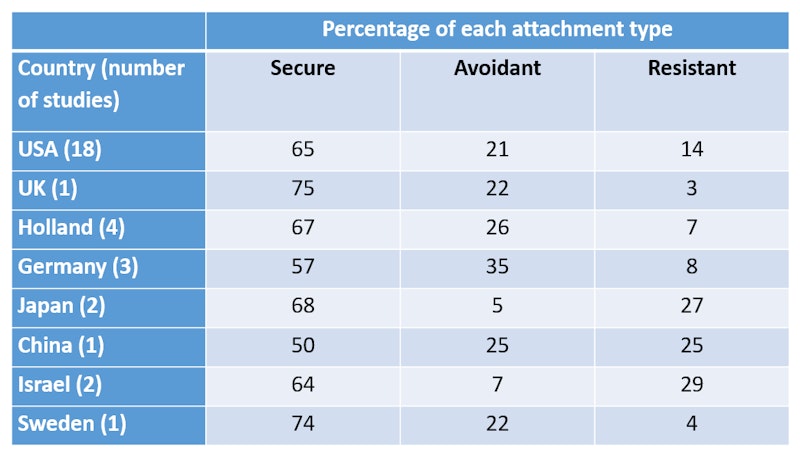Study Notes
Cultural Variations in Attachment
- Level:
- AS, A-Level
- Board:
- AQA, Edexcel, OCR, IB
Last updated 21 Apr 2023
The Strange Situation procedure has had a profound impact within developmental psychology and has become a recognised and validated method to assess individual differences in attachment types. The procedure has been used in a variety of cultural settings to identify whether patterns of attachments appear to be universal or are subject to cultural influences. One of the most commonly cited cross-cultural studies which uses the Strange Situation procedure was conducted by Van Ijzendoorn & Kroonenberg’s in 1988.
Van Ijzendoorn & Kroonenberg’s (1988) meta-analysis summarized findings from 8 countries, which included the UK, US, Sweden, Japan, China, Holland, Germany & Israel. The meta- analysis examined 32 studies and consulted nearly 2000 Strange Situation classifications in total. The meta-analysis yielded a number of findings and conclusions:

- Average findings were consistent with Ainsworth’s original research - Secure 65% - Avoidant 21% - Resistant 14%
- Intra-cultural variation was nearly 1.5 times greater than the cross-cultural variations. Van Ijzendoorn speculated that this was linked to differences in socio-economic factors and levels of stress that varied between samples used within each country.
- 6/8 countries produced findings that were proportionally consistent with Ainsworth & Bell (70).
- Japan & Israel revealed a higher incidence of resistant than avoidant children.
- Chinese findings revealed the lowest rate of secure attachments (50%) with the remaining children falling into the other categories equally.
- It was concluded that the modest cross-cultural differences reflect the effects of mass media, which portrays similar notions of parenting.
Evaluation of Van Ijzendoorn & Kroonenberg
Strengths
Comparison is aided by the standardised methodology. The use of the strange situation as a procedure means that a comparison can be made across cultures, and the reliability is therefore high
Weaknesses
The study was not globally representative -Van Ijzendoorn & Kroonenberg recognised that data from less Western-oriented cultures were required to establish a more global perspective attachment classifications, pointing out that Africa, South America, and Eastern European socialist countries were not represented.
Overall findings are misleading - As a disproportionately high number of the studies reviewed were conducted in the USA (18/32), the overall findings would have been distorted by these. This means that the apparent consistency between cultures might not genuinely reflect how much attachment types vary between cultures.
Applying Strange Situation procedures and behavioural categories is ethnocentric – Cross-cultural research using the Strange Situation judges and categorises infant behaviour according to behavioural categories that were developed following observations of middle-class American infants. This means that when researchers interpret non-American infant behaviour, it is being judged against an American standard. Eg. an infant exploring the playroom by themselves would be classed as avoidant based on American standards but is valued as reflecting independence in Germany
Takahashi (1990)
Takahashi (1990) replicated the Strange Situation with 60 middle class Japanese infants & mothers using the same standardised procedure and behavioural categories. Takahashi’s observation revealed distinct cultural differences in how the infants responded to the 8 stages of the procedure. The findings were as follows:
0% insecure-avoidant. Infants became severely distressed in the “infant alone step”; this situation was quite unnatural and broke cultural norms for the infants
32% insecure-resistant
68% secure
90% of infant-alone steps had to be stopped due to excessive infant anxiety.
Evaluation of Takahashi
A weakness of the research is that it could be seen as unethical – It could be argued that Takahashi’s research was unethical as the harm that the procedure caused exceeded what infants would be exposed to in their day-to-day lives meaning that it exceeded undue risk. As Japanese infants are rarely separated from their primary caregivers, the infant-alone step induced stress that they would not normally encounter and so the level of harm can be considered unjustifiable. Despite this being the case, the researchers did stop infant-alone steps prematurely in an attempt to protect infants from further harm.
You might also like
Bowlby’s Theory of Attachment
Study Notes
Animal Studies of Attachment: Lorenz and Harlow
Study Notes
Bowlby's Theory of Maternal Deprivation
Study Notes
Stages of Attachment Identified by Schaffer
Study Notes
Multiple Attachments and the Role of the Father
Study Notes
Anxiety
Study Notes
Ainsworth’s ‘Strange Situation’
Study Notes